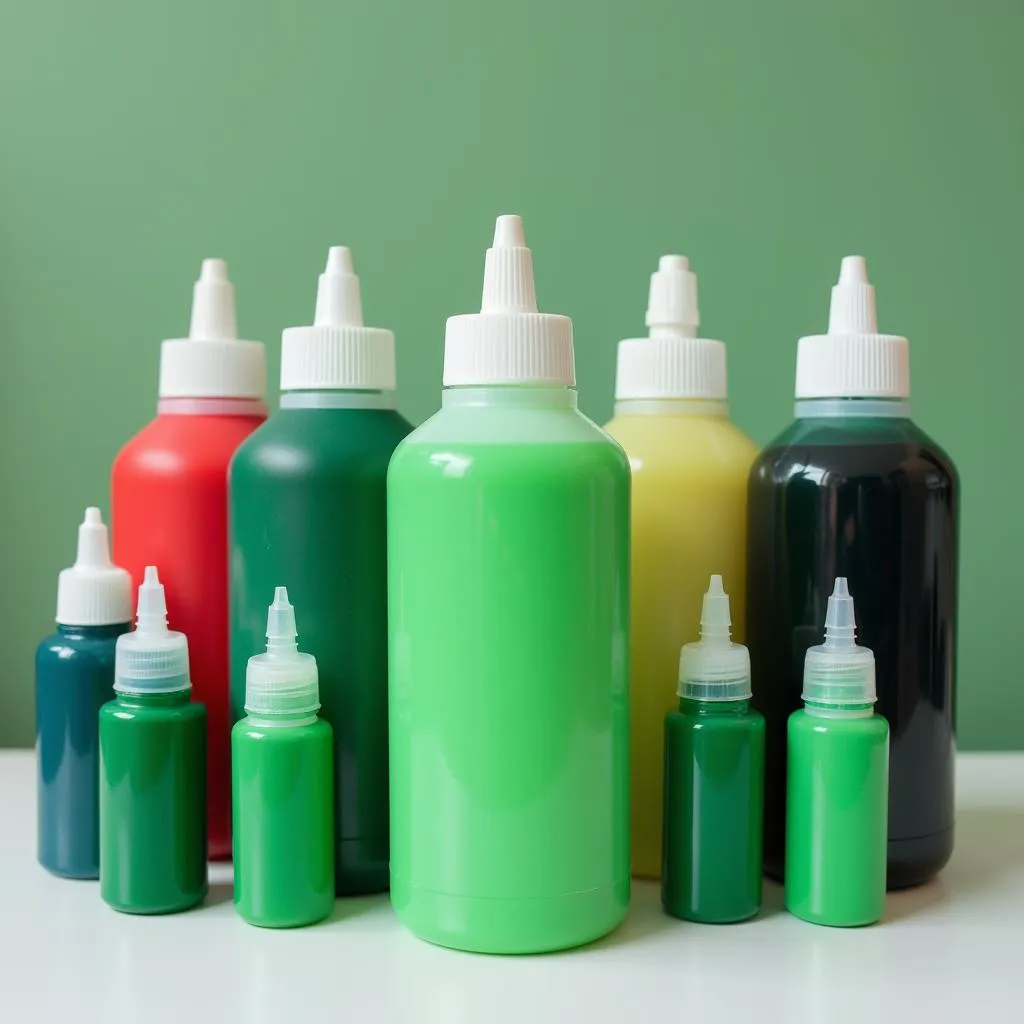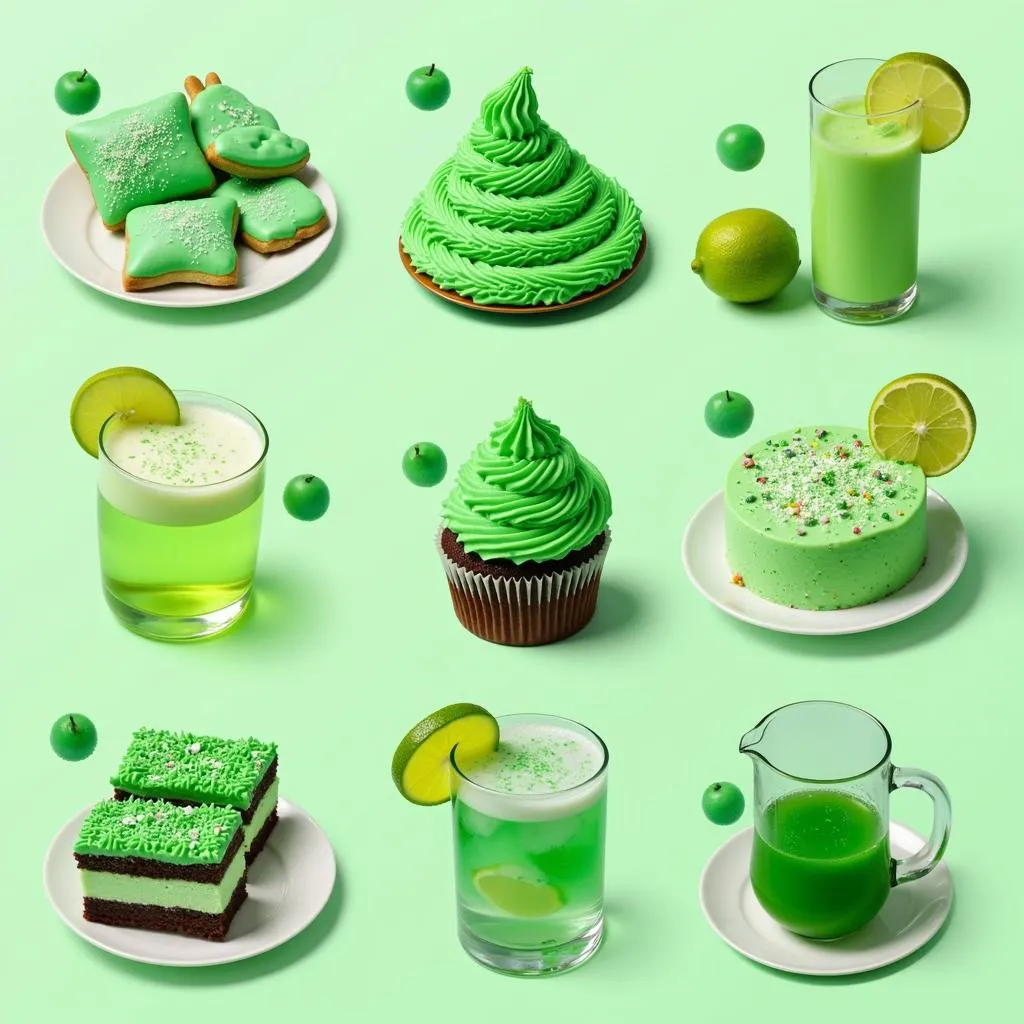Green Food Dye is a staple in any baker or home cook’s kitchen who loves to add a splash of color to their culinary creations. Whether you’re whipping up a batch of vibrant green frosting for St. Patrick’s Day or aiming for a subtle green hue in your homemade pasta, green food dye provides the versatility to achieve your desired color. But with so many different types of green food dye available, it can be challenging to know which one is right for you.
 Green food dye bottles on a table
Green food dye bottles on a table
What is Green Food Dye?
Green food dye is a colorant used to add a green hue to food or drinks. It can be natural, derived from sources like spinach or spirulina, or artificial, created using synthetic colorants.
Types of Green Food Dye
There are two primary types of green food dye:
1. Natural Green Food Dye
This type of dye is made from fruits, vegetables, or algae that possess natural green pigments. Common sources include:
- Spinach: Offers a vibrant green color and can be easily processed at home.
- Spirulina: This blue-green algae produces a deep, rich green color and is a popular choice for vegan and natural food coloring.
- Wheatgrass: Known for its bright green hue, wheatgrass is a nutritious option for adding color to foods and drinks.
- Matcha: Derived from green tea leaves, matcha imparts a unique earthy flavor along with its vibrant green color.
While natural green food dyes are appealing for their health benefits and eco-friendly nature, they may:
- Require a larger quantity to achieve the desired color intensity
- Affect the taste of your recipe, depending on the source
- Fade more quickly than artificial dyes
2. Artificial Green Food Dye
Artificial green food dyes are synthetically produced and offer advantages such as:
- Color Concentration: A little goes a long way, delivering vibrant color with just a few drops.
- Stable Color: Artificial dyes tend to hold their color better over time and are less likely to fade when exposed to light or heat.
- Tasteless: They don’t impart any flavor to your recipe, ensuring your dish tastes exactly as intended.
 Green dyed frosting on cupcakes
Green dyed frosting on cupcakes
However, some drawbacks of artificial dyes include potential health concerns associated with synthetic ingredients and a growing consumer preference for natural alternatives.
How to Choose the Right Green Food Dye
When choosing a green food dye, consider the following factors:
- Type of Food: The type of food you’re coloring can influence your choice. For instance, natural dyes work well for frosting, while artificial dyes might be better for candy melts due to their heat stability.
- Desired Shade: Determine the intensity of green you want to achieve. Some applications may call for a subtle hint of green, while others might require a bold and vibrant hue.
- Dietary Restrictions: Opt for natural green food dyes if you have dietary restrictions, such as veganism or allergies.
- Ingredients: Always check the ingredient list, especially if you’re concerned about artificial colors or additives.
Tips for Using Green Food Dye
Here are some helpful tips to get the best results when using green food dye:
- Start Small: Add a small amount of dye at a time, gradually increasing until you reach your desired shade.
- Mix Thoroughly: Ensure the dye is evenly distributed throughout your food or batter to prevent streaks or uneven coloring.
- Consider the Base Color: The original color of your food will impact the final shade. For example, adding green dye to a yellow batter will result in a brighter green than adding it to a white batter.
- Light Sensitivity: Keep in mind that some green food dyes, particularly natural ones, can fade when exposed to light.
- Storage: Store your green food dye properly to maintain its color and prevent it from drying out.
Green Food Dye FAQs
Here are answers to some commonly asked questions about green food dye:
1. Is green food dye safe to eat?
Both natural and artificial green food dyes are generally safe for consumption when used in moderation. However, it’s essential to choose dyes approved for food use and follow the recommended usage guidelines.
2. Can I mix green food dye with other colors?
Yes, you can mix green food dye with other colors to create a broader spectrum of shades. For instance, combining green with yellow can create a vibrant lime green, while mixing it with blue can yield a teal color.
3. How do I make green food dye at home?
You can make natural green food dye at home using spinach, spirulina, or other green vegetables. Blend the chosen ingredient with a small amount of water, strain the mixture through a fine-mesh sieve, and use the resulting liquid as your natural green food dye.
4. What are some creative uses for green food dye?
Beyond baking, green food dye can be used creatively in various applications. It can be used to dye homemade playdough, slime, or even Easter eggs, offering endless possibilities for crafts and activities.
5. Where can I buy green food dye?
Green food dye is readily available in the baking aisle of most grocery stores, specialty food stores, and online retailers.
 An assortment of vibrant green colored foods like frosting, cookies, and drinks.
An assortment of vibrant green colored foods like frosting, cookies, and drinks.
Conclusion
Green food dye is a fun and easy way to add a splash of color to your culinary creations. Whether you’re a baking enthusiast or just want to make your meals more visually appealing, understanding the different types of green food dye and their properties will help you achieve the best results. So, unleash your inner artist and experiment with green food dye to create stunning and delicious masterpieces in your kitchen!
For any assistance, please contact Phone Number: 02437655121, Email: [email protected] Or visit us at: 3PGH+8R9, ĐT70A, thôn Trung, Bắc Từ Liêm, Hà Nội, Việt Nam. We have a 24/7 customer support team.